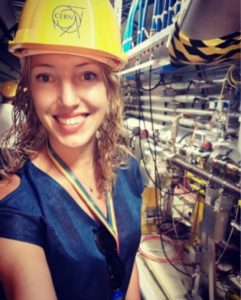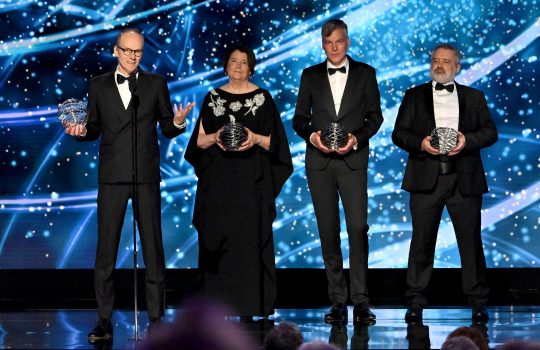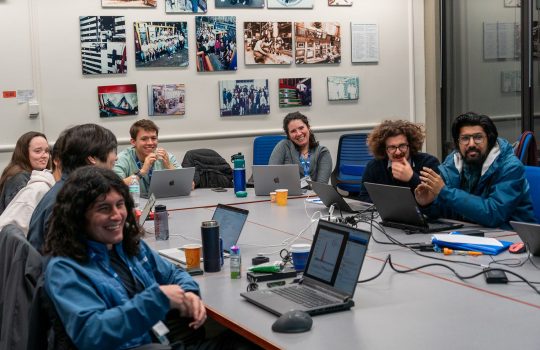
Claire Lee inside the CERN LHC tunnel at Point 4 where protons are given a kick of speed. Photo: Claire Lee
How long have you worked with the U.S. Department of Energy’s Fermi National Accelerator Laboratory?
Almost three years. I did my Ph.D. on the ATLAS experiment, then I did a postdoc with Brookhaven National Laboratory. I joined Fermilab in March 2020. But I’ve been based here at CERN in Switzerland since the summer of 2011.
What brought you to Fermilab?
So much of my career has been being in the right place at the right time: people asking, “Oh, would you like to do this?” and me saying, “Yes, that that sounds like a lot of fun! Let’s go do that!”
I did a master’s in South Africa on an experiment at Jefferson Lab’s Hall C, which is a fixed-target, high-energy nuclear physics experiment rather than a particle physics collider experiment. My advisor and I were the first two people from a South African university to join ATLAS, thanks to a collaboration with Kétévi Assamagan and others from Brookhaven. Then I started a Ph.D. with ATLAS.
After my postdoc, I just wanted a bit of a change and to do more of the outreach and public engagement side of things, which I really enjoy. That was one of the main reasons that I moved over to Fermilab.
What are you working on now?
Right now, I am working for Fermilab on the CMS experiment. Specifically, I am working on the communications and operations teams. We have this amazing, complex detector that thousands of people built over decades, and we want to be able to make sure we make the best use of it and get every exciting bit of physics we can out of it. LHC Run 3 started last year, but all of the collisions the LHC will produce will be worthless if we don’t have our detector on and running in optimal condition to detect and measure the particles that come out of those collisions. The very first, critical step in the entire process of producing great physics results is being able to keep our detector running safely. When I am on shift at Point 5 where the CMS detector is located, I am basically the first human point of contact for all the detector hardware, as well as responsible for any people on site doing technical work or taking visitors underground.
I really enjoy the shifts because each day is different. Some days are calm; some days you’re working intensely with subdetector experts to help them while they troubleshoot something; and some days you’re having to call the fire department because a bird has got itself stuck in the cavern! But it’s great because no matter what, you feel like you’re contributing in real time to the success of the experiment.
One of the wonderful things about our experiment is that it has such a wide, international collaboration, and another part of my job is to work on developing this as an advantage on the operations side too. Fermilab has the CMS Remote Operations Centre, which is basically a secondary control room for CMS at Fermilab. Between myself liaising from CERN and the team at the Fermilab, we are working on developing a new distributed operations model where we can use the ROC to support and complement the on-site operations at CERN. In essence, we could have US-CMS physicists taking CMS shifts without needing to travel very far. I think, in 2023, where we’ve just gone through the learning experience of a global pandemic, which heavily curtailed our travel, and with sustainability as a key goal for the future, this is a really important effort, and it would be a first for LHC experiments, too.
I also work with both the CMS and the Fermilab communications teams. I’ve also just trained as a guide for CMS, so I can take visitors underground. Also, because I previously worked on the ProtoDUNE project for the last couple years, I coordinated visits for the CERN Neutrino Platform. So, I’m also helping with visits there, but I’ll be passing this responsibility over to someone else soon.
Tours are super fun — a lot of talking to people, a lot of telling people how cool physics is. It’s so rewarding when people walk into the cavern, see the detector, and they’re like, “Wow, this is so cool,” and really understand what’s going on.
What are the goals of the CMS experiment?
One of the biggest goals was to discover the Higgs boson or basically see if we can figure out what it is that is giving mass to all the particles in the universe. That happened 10 years ago: The CMS and ATLAS experiments discovered the Higgs boson, which was really great because it was a huge missing piece in our understanding of the universe. But there are still many unanswered questions. For one, is that the only Higgs boson, or are there more of them? That’s one of the things that we’re looking for.
Another thing is that if we total up all the particles that we know of, it only makes up 5% of the universe; there’s 95% of the universe that we don’t know about. We think that at least some of that 95% acts like matter, and we call it dark matter. This is another big thing that we’re investigating. We’re hoping that studying proton‑proton collisions with the CMS is going to be one of the ways that we can shed some light on the nature of dark matter, even if we are not able to produce it directly with our accelerator.
The universe is a really interesting place, and if we truly want to say we understand it, we need to measure the way matter behaves across as wide a range of energies as possible with our current technology.
You’ve been vocal about your recent ADHD diagnosis and advocating for folks with ADHD in the sciences. Did your diagnosis impact your career?
You know, it’s kind of like particle physics. Once we understand how the particles and everything work, then we better understand the universe. In the same way, once you understand how your brain works, then you can do things either to help or hinder you.
While I was going through all of my research, I didn’t actually know that I had ADHD; I just sort of plodded along. With hindsight, I think a lot of things make sense. It took me years and years and years to do my master’s because I would spend weeks just staring at the screen doing nothing, then go off on a tangent, and then spend two weeks where I did a bunch of stuff because I was super motivated for this one little piece. Then once I completed that, I lost motivation again. So yeah, it’s an interesting thing to look back on.
One of the things that I used to occasionally do — without understanding why it worked — and now try to do more is when I have a task I need to do, I give myself the reward as I start. Because the thing with ADHD is being unable to start and then being unable to stop. Figuring out ways in which you can give yourself the reward at the beginning to get started can be pretty helpful. My brain really does enjoy standing up and talking to people so if I can do that a lot and make that more of my job, that’s fantastic.
What do you enjoy doing outside the lab?
I used to run a lot, but I injured my foot over a year ago; it still hasn’t recovered.
I started violin lessons in November, so that’s fun! I’ve got an electric violin — my husband bought me one as a present couple of weeks ago, and it’s super cool. I’m very much a beginner. The nice thing with the electric violin is that I can put headphones on when I’m playing at home, and then my cats don’t hate me so much.
Otherwise, just spending time with my family and friends is great.
Fermi National Accelerator Laboratory is supported by the Office of Science of the U.S. Department of Energy. The Office of Science is the single largest supporter of basic research in the physical sciences in the United States and is working to address some of the most pressing challenges of our time. For more information, please visit science.energy.gov.



